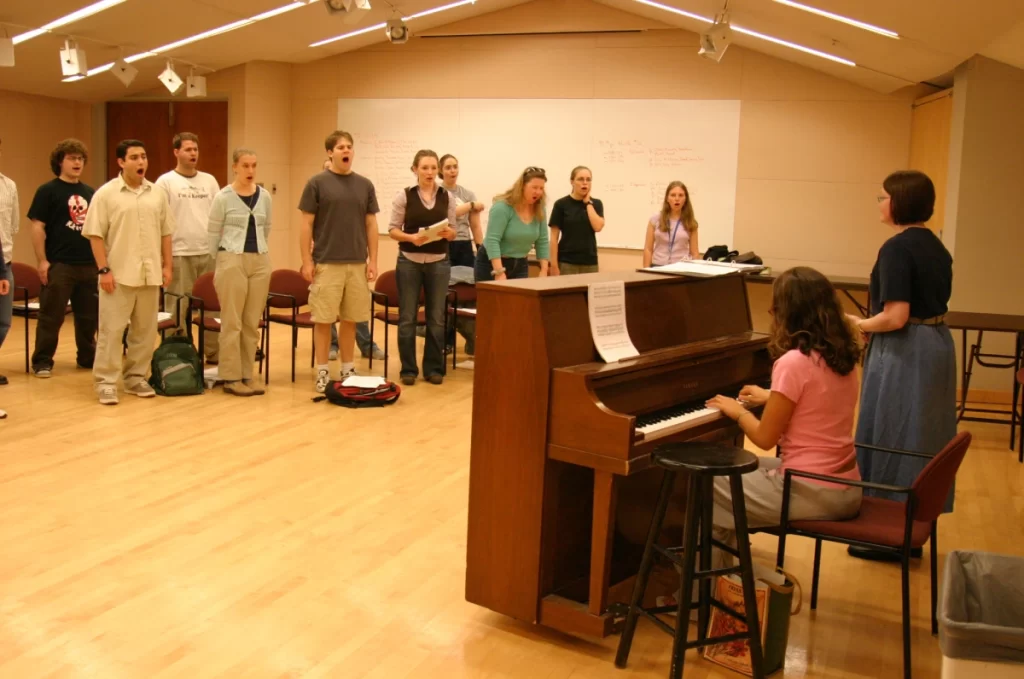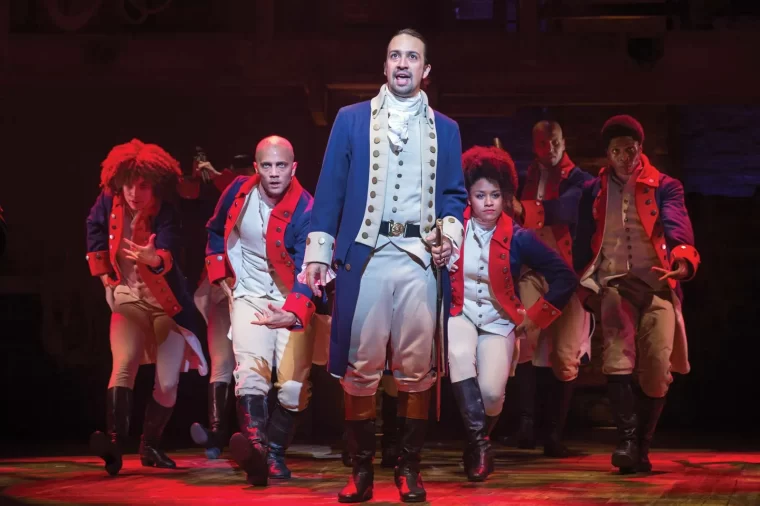In this blog post, I will be continuing my research for my story project. This time, I will be researching about the rehearsal process of a musical after you are casted, and I hope that my research will make my story more true and come to life. First of all, here are all the elements of rehearsal in order to put a show together:
Rehearsals: The Music Director (MD) teaches the music to the cast in rehearsals, which is often the first step in the rehearsal process for a musical. The MD continues to work with the actors in the weeks leading up to performances, not just to make sure they’re singing the right notes but to shape the sound and interpret the music with the actors. The MD often also accompanies these rehearsals on piano. [1]
Band Rehearsals: These happen concurrently with acting rehearsals. While actors usually get a three to five week rehearsal process before Tech Rehearsal, the band will often have just two to five sessions to put the score together! [1]
Sitzprobe: This is a German word that means “sit and sing.” In theater, it’s the first time the actors and the band get together to sing and play through the entire score. They don’t worry about scenes or staging, it’s just about listening to how the vocals and the instrumentals come together. [1]
Band Seating: This is the moment the band arrives at the theater. The Sound team begins setting up mics and monitors (a type of speaker that allows the band members to hear each other and the singers) and balancing the volume of the instruments for the audience. [1]
Wandelprobe: This means “wander and sing.” This is the first time the cast runs through the show, including blocking and choreography, with the band playing along. [1]
Tech Rehearsals: These are a few days of long rehearsals where lighting, sound, costumes, sets, and props are added into the mix. Usually this goes pretty slow, so the band isn’t called for the first couple of days, and rejoins the group once these new elements are mostly integrated. [1]
Previews: These are public performances with full band and tech while rehearsal is continuing. This is an important time when the Artistic team gets to listen to the audience’s reaction, helping them to further shape the production. Ticket for Previews are often sold at a slight discount because the work is still settling, though the average theater-goer wouldn’t see the difference onstage. [1]
Opening Night: This is when the show freezes (stops rehearsing and changing) and enters its regular performance schedule. It’s quite a finish line for all involved, and there’s usually a celebration to go along with a job well done. [1]

Next, here is some more research on what happens during the actual rehearsal process:
First Rehearsal: There is tremendous excitement when the cast and crew come together for the first time. First rehearsal begins with presenting the production team. The stage and musical directors make brief introductory remarks, followed by a full read through of the show by the cast. If the leads are prepared, they can sing their numbers – otherwise, the musical director can do the honours. If time allows, go right into blocking one of the ensemble scenes. Make it clear that rehearsals will be busy events and that you will not be wasting time. The atmosphere should be upbeat and positive. Do not tolerate improper behavior. Make it clear that the way for everyone to have a good time at rehearsals is by going a good job. A director’s sense of focus can be contagious. Set the right tone at this point and the entire rehearsal process will benefit from it. [2]
Day By Day: About three weeks into rehearsals, it is time for the cast to start working “off book.” If any actors decide to do this earlier, all the better. It can inspire others to do the same. At this point, have the stage manager (or another assistant) on duty to “throw” the actors any lines they forget. Make it clear that it’s okay for performers to forget lines at this stage, but everyone must have their parts memorized. The stage manager or assistant director who “throws lines” to the actors must always do so in a pleasant, nonjudgmental manner. Correcting actors is the director’s job. At the end of each full cast rehearsal, cast notes are customary. The entire company sits down while the musical and stage directors offer pointers on anything that requires special attention. Major problems with individuals are often handled in private discussions. The tone of these notes must be as encouraging as possible – negative or angry outbursts can backfire, especially in front of the entire company. However, if the ensemble is goofing off, let them know how disappointed you are. [2]
Costume Fittings: Schedule costume fittings separately from formal rehearsal times if you can, but not all groups have that luxury. Have final fittings handled one to two weeks before show time, if possible. If costume rentals leave you with a tighter schedule, allow as much time for adjustments as you can. Have seamstresses from your costume crew on hand for all dress rehearsals and performances – buttons, zippers and seams can disintegrate at the darnedest times, and someone wielding a competent needle can be a lifesaver. [2]
Tech Rehearsal: The technical rehearsal is when the full cast and crew walk through the entire show in performance order, making sure every light cue, sound effect, microphone, etc. works as planned. This means stopping hundreds of times to make adjustments. No one needs to act or sing — this rehearsal is for the tech staff. [2]
If this is your first time running a tech rehearsal, know in advance that lots of things will go wildly wrong – equipment that has always worked suddenly won’t, and little staging problems will turn into insurmountable barriers. You want these disasters to happen now, rather than in front of an audience. While it is always important for the director to be an island of calm command, it is especially true during tech rehearsals. Have the cast in costume so lights and microphone placement can be adjusted. The actors will find this tiring, as even a simple scene may require hours of adjustment. Explain that they will have to live with this process just like the pros do. Encourage the cast to conserve their voices. For this rehearsal, they are primarily on hand to help the tech crews light and amplify them to best advantage – there are no cast notes. You don’t know when or of it will be possible to allow an extended break. Some find it practical to include a planned meal break, ordering in pizza or having everyone brown bag it. It is not unusual for tech rehearsals to run into the wee hours. Scheduling this on a Friday or Saturday, most people won’t be as concerned with running late. An even more sensible option is to divide your tech into two rehearsals, one per act. This may be less traditional, but it beats people dragging themselves home at 3 AM. [2]
Dress Rehearsals: Schedule more than one dress rehearsal, especially for shows involving elaborate sets, costuming and/or effects. This is your last opportunity to correct any remaining costume and tech issues. Preliminary dress rehearsals are a great time to stage curtain calls. Keep the bows simple and swiftly paced, giving all featured players recognition. Schedule the final dress rehearsal two days before your first performance. This is a tough moment for stage directors. After today, their baby will have to walk on its own. At this rehearsal, directors must let each act flow from beginning to end. Behave as if this is a performance. When something goes wrong, let the cast & crew must handle. The director only intervenes if there is a genuine emergency. Amateur performers often ask what special things they can do to prepare for the opening. It helps to avoid screaming their lungs out at sports events, or consuming any illegal drugs or booze. Other than that, the best thing anyone can do is to follow their normal routine. That makes it easier for bodies & minds to relax. [2]
Before the show: On opening night, an amateur company looks to its director for reassurance. Radiate goodwill and confidence. If you’ve done your job well, this will be easy to do now. You know your cast and crew are ready – well, ready enough! Make the rounds to as many people as you can to wish them well before the performance. If anyone prefers “break a leg” to “good luck,” there’s nothing wrong with enjoying theatrical tradition. The director’s opening night speech gives the company a last minute boost. Before the theatre is opened to the public, gather everyone together on stage – cast, crew, ushers, etc. Tell them all what an incredible job they’ve done, that you are proud of them. Speak from the heart. Many directors like to have the whole company join hands for a moment of silent celebration. Then send everyone off to their appointed tasks with cheers and applause. It is customary in both professional and amateur theatre to begin the show five minutes after the announced curtain time, ten minutes in case of bad weather. This is a courtesy to the audience and minimizes the disturbance caused by latecomers. However, a painfully late curtain time is an insult. Don’t allow it. Unless your lead is stuck in a snow drift and the Mounties are on the way, start the show within ten minutes of your announced time. [2]
Showtime: One of the hallmarks of a successful amateur production is when a director can stand back and let the team do their jobs. Hovering around backstage can do more harm than good. It is time for the director to take a seat and enjoy the show. Nervously pacing at the back of the auditorium is something of a cliché, but forgivable – some of the greatest names in musical theatre were famous for it. If anything goes wrong, let your team handle it. Intervene only if there is a major emergency. There should be no unauthorized noise backstage, and no chatting or applause in the wings. I’ve seen good performances damaged by lighting crew audibly gabbing on their intercom system, or by actors gossiping in the wings where the audience can see and hear them. When you are amateurs, it is all the more important for you to show a professional sense of responsibility. After the show, there will probably be lots to celebrate. Family and friends will be on hand to offer congratulations – any notes from the director can be given before the next performance. Assuming that you have another performance the next day, try to conserve energies and voices. [2]
The Run: An amateur director is expected to be on hand for all performances. It is a sign of support for your company. Cast and crew have to keep up the energy level that came naturally on opening night. If your production runs for more than a few performances, it becomes more likely that someone may show up late or not show up at all. So long as it isn’t one of the leads, your team will have to find ways of proving the old adage that “the show must go on.” Of course, even that sacred maxim has its limits. What if the missing person is irreplaceable — the lead or a crucial tech person? If you are truly stuck and decide to cancel a performance, you will have to refund ticket sales, and will get no reduction in your rights fee. If there is a way for you to carry on that does not endanger your cast or compromise the show, go for it. Let the audience know what your problem is before the show, and odds are they will cheer you on all the way. After the thrill of opening, even a short run can suffer from something of a letdown. Cast or crew members often plan practical jokes for the final performance. Do not condone it. Remind everyone to keep a professional attitude to the end. [2]
Closing Night: Finish off your closing performance with a curtain speech. Different groups have different approaches to this. In some cases, the director does all the talking – in others, one of the leads speaks on behalf of the cast. Some directors have the cast share a few words privately after the show. See what fits most naturally for your company. Be sure the sets and lighting equipment are cleared from the performance area within a few days. Even if the school, church, or landlord is willing to give you longer, it is easier to get things done while team spirit is still high. Be sure to return any rented materials (scripts, scores, costumes, etc.) promptly. Others may be waiting for these items, and late returns can result in additional charges. [2]
And that’s it! That’s everything you need to know for putting on a musical. From the first rehearsal to closing night, an insane amount of work goes into making sure your show is well put together and everything is running smoothly. So the next time you go see live theatre, make sure you acknowledge and remember all the hard work that the cast members, directors, and backstage crew had to go through in order to present the wonderful show that is in front of you.

These are all the sources I used in my research,
- https://hvshakespeare.org/anatomy-of-a-musical/
- https://www.musicals101.com/puton12.htm#:~:text=The%20technical%20rehearsal%20is%20when,is%20for%20the%20tech%20staff.
Thanks for reading!



